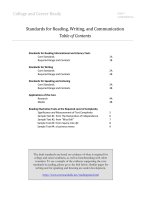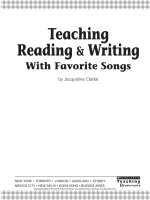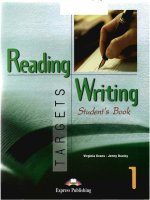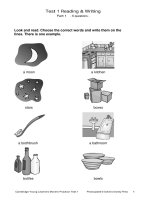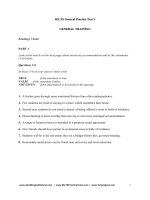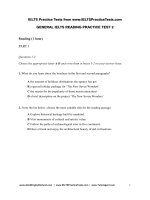Pathways 1 reading writing critical
Bạn đang xem bản rút gọn của tài liệu. Xem và tải ngay bản đầy đủ của tài liệu tại đây (40.7 MB, 243 trang )
Reading,
and
Critical
Mari Vargo
Laurie’ Blass,
H
Writing,
Thinking
NATIONAL
aun
esas
%2 CENGAGE Learning
From the Classroom to the World
We honor the mission and tradition of National Geographic Society: to inspire people to care about the planet.
People you will meet in PATHWAYS
Animal trainer
Planetary scientist
helps develop an
understanding between
dogs and their owners.
looks for clues to life on
other worlds,
Bioarchaeologist
[492668
beta TET)
)
Christine Lee
$tudies skeletons of
ancient people to trace
our human history.
p. 13
Singer-songwriter
BEET MUTE rd
tuses music to raise
aWereness of world
issues.
`.
Kevin Hand
p. 133
Mireya Mayor
travels through some
of the world's toughest
environments.
p. 125
Scientist
Katsufumi Sato
FS Wie (oa alee mace
penguins, and other
aniimals survive in their
nafural environiment.
[sam Ey
Environrmerttalist
Juan Martinez
Genetic researcher
connects inner-city kids
with the great outdoors.
p. 33
studies DNA patterns
to discover our global
Spencer Wells
connections.
p.45
Bioengineer
Kakani Katija
researches the behavior
of jellyfish and other sea
Musiolan
Zinny Thabethe
brings hope to millions
of people suffering from
animals.
IS co
p. 12
p.153
PATHWAYS
Mari
Vargo
NATIONAL
cocrapHic | ~~
LEARNING
Laurie
HEINLE
Blass
CENGAGE Learning:
;
Australia « Brazil » Japan s Korea s Mexico s Singapore + Spain * United Kingdom + United States
NATIONAL
Gane
~ - HEINLE
| a= CENGAGE Learning
Pathways 1
Reading, Writing, and Critical Thinking
© 2013 National Geographic Learning, a part of Cengage Learning
ALL RIGHTS RESERVED. No part of this work covered by the copyright herein
Publisher: Andrew Robinson
graphic, electronic, or mechanical, including but not limited to photocopying,
recording, scanning, digitizing, taping, Web distribution, information networks,
Mari Vargo and Laurie Blass
Executive Editor: Sean Bermingham
Senior Development Editor: Bill Preston
Assistant Editor: Vivian Chua
Contributing Editors: Sylvia Bloch,
ingrid Wisnieisle
Ditectorof Global Marketing: lan Martin
may be reproduced, transmitted, stored or used in any form or by any means
or information storage and retrieval systems, except as permitted under
Section 107 or 108 of the 1976 United States Copyright Act, without the prior
written permission of the publisher.
\
For permission to use material from this text or product,
submit all requests online at cengage.com/permissions
Further permissions questions can be emailed to
Marketing Manager: Emily Stewart
Directorof Content and Media Production:
Michael Burggren
Senior Content Project Manager: Daisy Sosa
Manufacturing Buyer: Marybeth Hennebury
Associate Manager, Operations:
Leila Hishmeh
Cover Design: Page 2 LLC
International Student Edition:
ISBN-T3: 978-1-133-31286-4
ISBN-10: 1-133-31286-1
U.S. Edition:
Cover Image: Julien Gille/iStockphoto
BBN S782 SIE!
Interior Design: Page 2, LLC
ISBN: 1133-31711
Composition: Page 2, LLC
National Geographic Learning
20 Channel Center Street
Boston, MA 02210
USA
Cengage Learning is a leading provider of customized learning solutions with
office locations around the globe, including Singapore, the United Kingdom,
Australia, Mexico, Brazil, and Japan. Locate your local office at:
ngl.cengage.com
Cengage Learning products are represented in Canada by Nelson Education, Ltd.
Visit National Geographic Learning online at ngl.cengage.com
Visit our corporate website at www.cengage.com
Printed in the United States of America
1234567815
141312
Contents
Scope and Sequence
Explore a Unit
1
r2
3
Life in a Day
Learning Experiences
Family Ties
ry
The Trouble with Trash
5
The World in Our Kitchen
6
7
8
9
O
Future Living
Exploration and Discovery
Musicians with a Message
Behavior
The Power of Image
Video Scripts
Independent Student
Handbook
Vocabulary and Skills Index
PLACES
TO
EXPLORE
ing amazing unexplored world
s of the Bahamas. page 132
& Artist Vik Muniz and workers at
Rio's Jardim Gramacho landfil
An area of garbage in
the North Pa
be twice tl
he United Sĩ
TS
turn trash into art. page 72
IN
PATHWAYS
from the Congo are taking street
music to the world. page 145
MÔ
ec
~
PCr on
only in the jungles of
Madagascar.
page 129
4 In Mongolia, mobile “ter
make education available to
everyone.
page 33
;
4 Will humans one day leave our planet
to live on Mars?
page
112
Life in a Day
Academic Track:
Interdisciplinary
Academic Pathways
Vocabulary
Lesson A:
nding meaning
from conte:
Skimming for gist
Guessing meaning from context
Matching words with
Lesson B:
Reading interviews
Lesson C:
Understanding the writing process
Writing sentences about a
Word Link: word forms, un-
Word Partners: schedule
single topic
Understanding the main ideas of
paragraphs
Making inferences
Understanding meaning from
context
Using vocabulary to complete
definitions
Lesson B:
personaiized
Lesson A:
Learning
Experiences
Academic Track:
Sociology/Edueation
Family Ties
Academic Track:
History/Anthropotogy
Understanding news reports
Lesson C:
Academic Track:
Environmental
Academic Track:
Word Link: -in
Word Usage:
Lesson A:
Understanding meaning from
context
Finding the right meaning
Identifying fact and speculation
Lesson B:
Synthesizing map and textual
information
Lesson C:
Expressing speculation
Writing descriptive sentences about
family
Finding supporting Ic
Analy: ng G:
Lesson B:
Unde standing a muitimod
Lesson C:
ord
Word Partners: trip
Using vocabulary to complete
definitions
Applying vocabulary in a
personalized context
Word Link: migr
Word Partners: common
Understanding meaning
from context
Applying vocabulary in a
personalized context
Word Partners: ca:
despite
Using de
riting
Lesson A:
The World in
Our Kitchen
context
Planning your writing
Writing sentences about goals
Lesson A:
The Trouble
with Trash
Applying vocabulary in a
Scanning for key details
Reflecting critically
Lesson B:
Identifying pros and cons in a
passage
Under
context
App
personalized
ing meaning from
coi
Word Partner:
Reading
Writing
Viewing
Critical Thinking
Responding to statistics
Goal:
Video:
Making inferences
Analyzing and discussing
information
Synthesizing information to
identify similarities
Predicting for main idea
Understanding the gist
Identifying key details
Writing sentences about
daily activities
Grammar:
BioBlitz: Life in 24
Hours
Skill Focus:
Skill:
Understanding the writing
process
Viewing for general
understanding
Viewing for specific
information
Relating video content
to a reading text
Interpreting maps
Predicting for main idea
Scanning for specific information
Identifying key details
Differentiating main ides from
supporting details
Goal:
‘Video:
Skill Focus:
Planning your writing
Organizing information in a Venn
Diagram
Skimming for gist
Understanding the main ideas of
Simple present of be and
other verbs
Writing sentences
about personal goals
Grammar:
Using want and need
Skill:
Alex the Parrot
Viewing to confirm
predictions
Viewing for specific
information
Relating video content
to a reading text
Analyzing stages in a process
CT Focus:
Guessing meaning from context
Making inferences:
Analyzing reasons and
motivations
Synthesizing information to
identify similarities
CT Focus:
Inferring character traits
paragraphs
Responding to texts and photos
Scanning to make predictions
Understanding the gist
Identifying main ideas of paragraphs
Identifying key details
Identifying facts and speculations
Skill Focus:
Finding the right meaning
Responding to texts and photos
Using titles and visuals to make
predictions
Understanding the gist
Identifying main ideas
Scanning for key details
Identifying supporting ideas
Understanding information in graphs
Skill Focus:
Goal:
Writing descriptive
sentences about family
Predicting the content of a reading
Understanding the gist
Identifying main ideas of
paragraphs
Sequencing steps in a process
Identifying advantages and
disadvantages
Skill Focus:
Scanning for key details
The World in a Station
Skill:
Viewing for general
understanding
Viewing for specific
information
Personalizing video
Goal:
Video:
Grammar:
Simple past of be and
other verbs
Speculating
Writing sentences to
make suggestions
Using details to clarity
ideas
Goal:
Video:
Grammar:
Giving advice and
making suggestions
Skill:
Writing sentences to
express an opinion
Grammar:
Comparative forms of
adjectives and nouns.
Skill:
Using synonyms to
avoid repetition
Synthesizing information to
make a decision
Speculating about reasons
CT Focus:
Analyzing fact and speculation
content
Trash People
Viewing to confirm
predictions
Viewing for general
understanding
Viewing for specific
information
Relating video content
Finding supporting ideas
Interpreting maps and charts
Video:
Analyzing solutions to problems
Analyzing a graph to classify
information
‘Synthesizing information from
multiple sources
Evaluating possible solutions
CT Focus:
Analyzing causes and effects
to reading texts
Earth University
Viewing to confirm
predictions
Viewing for general
understanding
Viewing for specific
information
Personalizing video
Personalizing content of a
reading
Evaluating arguments for and
against an issue
Synthesizing map and textual
information
CT Focus:
Reflecting on own
preconceptions
content
SCOPE
AND
SEQUENCE | vii
|
Scope
and Sequence
Academic
Pathways
Lesson A:
Future Living
Page
107
Academic Track:
Understanding pronoun reference
Evaluating a writer's attitude
Lesson B:
Understanding a multimodal text
Vocabulary
Understanding meaning from
context
Applying vocabulary in a
personalized context
Word Partners: intelligence,
plant
Science/Sociology
Lesson C:
Using pronouns to avoid repetition
Writing sentences about the future
Word Usage: average
7
Lesson A:
Understanding meaning from
Exploration
and Discovery
Understanding prefixes
Evaluating reasons
Lesson B:
Page 121
Understanding an explanatory text
and infographic
Academic Track:
Lesson C:
8
Taking notes
Understanding idiomatic language
Interdisciplinary
Message
Page
141
Academic Track:
Art/Music
9
Page
Lesson B:
167
Academic Track:
Life Science/
Anthropology
Word Link: reWord Partners: follow, phrasal
verbs with run
Understanding meaning from
context
Applying vocabulary in a
personalized
context
Reading interviews and profiles
Brainstorming ideas in a
word web
Lesson C:
Word Link: ais-
Presenting one main idea in a
paragraph
Writing sentences to explain a
preference
Lesson A:
Behavior
Using new vocabulary in an
everyday context
Linking examples and reasons
Writing sentences to give reasons
Lesson A:
Musicians
with a
context
Recognizing noun clauses
Making inferences from an
interview
Word Partners: issue
Understanding meaning from
context
Using new vocabulary in an
everyday context
Lesson B:
Reading news articles about science
Word Partners: research, field
Lesson C:
Writing a topic sentence
Writing a paragraph to compare
animals
10
Lesson A:
The Power of
Image
Page
181
Academic Track:
Interdisciptinary
Recognizing subordinating
conjunctions
Understanding moo
Lesson B:
Reading a personal narrative
Lesson C:
Using supporting ideas in a
Understanding meaning from
context
Using new vocabulary in an
everyday context
Brainstorming words to describe
emotions
Word Link: vis
Word Usage: belong
Word Partners: p/
Reading
Using texts and visuals to make
predictions
Scanning to make predictions
Understanding the gist
Identifying main ideas of paragraphs
Identifying key details
Sequencing events in a timeline
Writing
Viewing
Critical Thinking
Goal:
Video:
Inferring and identifying reasons
Personalizing Information in a
reading
Writing sentences to
make predictions
Grammar:
Using and, but, and so
Colonizing Mars
Viewing to confirm
predictions
Viewing for general
Using pronouns to
avoid repetition
understanding
Viewing for specific
information
Relating video content
to a reading text
Interpreting a timeline
Using titles and visuals to make
Goal:
Video:
give reasons
Madagascar Discovery
Identifying main ideas
Identifying key details
Sequencing events in a timeline
Labeling a diagram
Grammar:
Skill Focus:
Skill:
Understanding pronoun reference
predictions
Skill Focus:
Understanding prefixes
Understanding a chronology
Scanning to make predictions
Understanding the gist
Identifying main ideas of sections
Identifying key details
Using notes to understand key ideas
Skill Focus:
Taking notes
Responding to text and photos
Understanding the gist
Scanning to identify key details
Identifying main ideas
Understanding pronoun reference
Skill Focus:
Recognizing noun clauses
Responding to photos
Skimming/Scanning to make
predictions
Understanding the gist
Identifying main ideas of paragraphs
Relating key details to visuals
Identifying events in a narrative
Skill Focus:
Recognizing subordinating
conjunctions
Writing sentences to
Giving reasons with
would like to + because
Skill:
Linking examples and
reasons
Goal:
Writing sentences to
explain a preference
Grammar:
Giving reasons using
therefore and since
Skill:
Presenting one main
idea in a paragraph
Goal:
Writing a paragraph to
make a comparison
Grammar:
Making comparisons
Skill:
Writing a topic
sentence
Goal:
Writing a descriptive
paragraph about a
photograph
Grammar:
Describing spatial
relationships and
emotions
Skill:
Using supporting
ideas in a descriptive
paragraph
Viewing to confirm
predictions
Viewing for general
understanding
Viewing for specific
information
CT Focus:
Evaluating a writer's attitude
Inferring and identifying reasons
Personalizing information in a
reading
CT Focus:
Evaluating reasons and
motivations
Relating video content
to a reading text
Video:
World Music
Brainstorming ideas
related to the video
Viewing for general
understanding
Viewing for specific
information
Evaluating relative importance
of issues
Reflecting on language
differences and similarities
Using notes for a group
discussion
CT Focus:
Interpreting idiomatic language
Relating video content
to a reading text
Video:
Gorilla Toolmakers
Using prior knowledge
Viewing for general
understanding
Viewing for specific
information
Synthesizing information to
make an evaluation
Inferring implicit information
Inferring a writer's assumptions
CT Focus:
Making inferences
Relating video content to
a reading text
Video:
Applying information to a new
Photo Camp.
Analyzing and discussing
Viewing to confirm
predictions
Viewing for general
understanding
Viewing for specific
information
Analyzing information in
a video
Relating video content
to a reading text
context
reasons
Evaluating photographs based
on criteria
CT Focus:
Understanding mood
SCOPE
AND
SEQUENCE
| ix
Each unit has three lessons.
Lessons A and B develop academic
reading skills and vocabulary by focusing
on two aspects of the unit theme. A
video section acts as a content bridge
between Lessons A and B. The language
and content in these sections provide the
stimulus for a final writing task (Lesson €).
The unit theme focuses on
an academic content area relevant to
students’ lives, such as Sociology and
Anthropology, Health Science, Business and
Technology, and Environmental Science.
Academic Pathways
highlight the main academic
skills of each lesson.
Exploring the Theme
Exploring
the Theme
provides a visual
introduction to the
unit. Learners are
encouraged to
think critically and
share ideas about
the unit topic.
Great Moments
in Exploration
A Historic Meeting
A UNIT
Leeson©: inking
Ving sentences to give reasons
In Preparing to Read, \earners are
introduced to key vocabulary items from the
reading passage. Lessons A and B each present
and practice 10 target vocabulary items.
Reading A is a single, linear text related
to the unit theme. Each reading passage is
recorded on the audio program.
Maps
and other
graphic
ak
es
co
cos
peo,
See |
ae
|
i sen Ss MO ter do ot {
formats
help to develop
learners’ visual
literacy,
Day6
‘scm
hy kin
capa
‘Sto
ales raeoars a anor
Soscatonou ess)
eangana
ae ioefen teert.may rợtee
Pron
te mot a nora Stearn
He enc
ny cit ha ret he tt.
aa
earn
ok at ie
Day 13,
eres Snes
b Ni
by
dị
0m
Kelty
TÔMto goenpdisainior
mien cpl sks llt8exbesee
tay
tt
eb tng fst oo
Day
Sorenle
Se
ect bento
Se
mer
Mein
Alte ynglenen xe inam cả
men
en
Feetng ond Fae EÀ
TH
2tr
til as re
Fy aioe
va re
Day 30
Tin A TH ceed nhga Ung TU nh
RA
Prikl eta
hen nado
Sodft beg
wo nd
Anh
Guided comprehension tasks
and reading strategy instruction
enable learners to improve their academic
literacy and critical thinking skills.
..
Reading Skil Uncerstntng
Prone
‘Arise con sorties fart ne eng ceva Houten honeonngotn ts
‘Hts
scan repy acne
guna be earsg oon to Ntome connor see
jaochiretie
`...
fof anyon wad carte, wae ened era
¬ xố...
son bước, /cØnke ngọt ok - ander Lao vi09adie.zdegsunddndae
| Senying ey Ont Sb
ac
pase 2-26 oa were
EXPLORE A UNIT
| xi
Igascar
Discovery
Viewing tasks relat ied
to an authentic National
Geographic video
serve as a content
bridge between
Lessons A and B.
(Video scripts are on
pages 203-208.)
READING
he Ce:
Learners need to use their critical thinking
skills to relate video content to information in
the previous reading.
Word Link and Word Partners boxes
develop learners’ awareness of word structure,
collocations, and usage.
”
Ty THE DAYS of Stanley
and Livingstone, much of the world was stil
on the surface of the world have been mapped. Some places, however,29
Some of these are underground, in đecp caves c ed blue holes,
A blue hole isa special kind of inland! underwater cave, T cave formate
Some of the world’s most spectacular? blue holes are |
|in the Ball
mote than a thousand blue holes. These caves are very deep: of exam
blue hole in the world, is more than 660 feet (200 meters) deep.
Diving into blue holes is extre rely dangerous. Near the top ofa blue h€
This gas causes itching, dizziness, and—in la e amounts—deach. Divel Is
t. Additionally, it’s very
in and our of a cave b re their oxygen ¢
Guided pre-reading tasks and strategy
tips encourage learners to think critically about
to get lost, Divers therefore have to fol 4 guideline? as they swim che!
{guideline, they may nor find their way back out of the cave
Irblue holes are so dangerous, why do explorers and scien
(One reason is that these underwater caves can provide vil
provide clues about geology, archaeoloy and even asteo™
such as
sniverse. For example, some blue holec
what they are going to read.
182
xil | EXPLORE A UNIT
found bacteria #
changed for millions of years. Divers have
life forms probably
existd! on Earth billions of years ago,
In addition, the oxygen-free environmentof the blue holes preserves
be
fell into the eaves long
By studying the blue holes, we can underst!
chink of no other envirot
times. As cave diver Kenny Broad says, “
to explore and gives us back so much scientifically.”
ARSOICERE
ORY! DI A
Critical thinking ,
tasks require
learners to analyze,
Lesson B’s
reading passage
presents a further
aspect of the unit
theme, using a variety of
text types and graphic
formats.
synthesize, and
critically evaluate
ideas and information
in each reading.
Bị
Authentic
charts and
graphics
from National
Geographic
support the
main text,
helping learners
lored. Today, most places
aiting to be discovered,
fe earth above it falls in,
te islands there may
ffs Blue Hote, the deepest
#8. ayer of poisonons gas.
[60 be fast. They have to get
shhese caves, so it is very easy
lve hole. If they lose the
ihcit lives to explore them?
entific information. They
athe study of life in the
ae, probably haven't
{ve without oxygen. Similar
mans and animals thar
life was like in prehistoric!
Earth that is so challenging
comprehend
Windows on an Alien World?
{An inland blue hole's water is very stil and has different
layers. A layer of fresh rainwater floats on top of salt
water, The fresh water keeps oxygen from
the atmosphere from reaching the salt
water. Brightly colored bacteria live where
the two layers meet. Scientists believe
these bacteria could teach us about
life in outer space. Astrabiologist
Kevin Hand says the bacteria
may be similar to forms of
that might exist on Jupiter's
fourth largest moon, Europa.
‘Our study of ife’s extremes
on Earth,” says Hand, can help
increase “our understanding
of habitable environments
off Earth.”
+ Hf something inland, away from
* {something is spectacular. its very
2 A guideline is ane ora rope tat.
* Prehistoric poopiea
the
impressive
ata me bet
saa
key ideas.
EXPLORATION
AND DISCOVERY | 133
EXPLORE
A UNIT
|
xiii
The Goal of
Lesson C
is for learners
to relate their
own views and
rn
si
=
|
oe
Integrated grammar practice and writing
skill development provides scaffolding for
the writing assignment.
experience to the
theme of the unit
by completing
a guided writing
assignment.
The Independent Student
Handbook provides further
language support and self-study
strategies for independent learning.
See pages 209-218.
Resources for Pathways Level 1
is Hổ đc
authentic National
Geographic clips relating
Teacher's Guide
PATHWA
_ toeach of the 10 units.
Teacher’s Guide
including teacher's notes,
expansion activities, rubrics
xiv | EXPLORE A UNIT
ch
for evaluating written
assignments, and answer
,
Audio CDs with audio
keys for activities in the
Student Book.
recordings of the Student Book
reading passages.
A guided process approach develops learners’ confidence
in planning, drafting, revising, and editing their written work.
Unit Quiz provides an opportunity for learners to review
some of the key ideas and language from the unit.
Assessment
Online Workbook, powered by MyELT,
with both teacher-led and self-study options.
CD-ROM with
ExamView®
containing a bank
of ready-made
questions for
quick and effective
assessment.
This contains the 10 National Geographic
video clips, supported by interactive,
automatically graded activities that practice
the skills learned in the Student Books.
pana
'PRESENTATION
Di TOOL.
Rhee
pate
Classroom Presentation Tool
CD-ROM featuring audio and video
Clips, and interactive activities from the
Student Book. These can be used
with an interactive whiteboard or
computer projector.
EXPLORE A UNIT
| xv
TEXT CREDITS/SOURCES
5-6, Adapted from “Life ina Day: About the Production”: 12-13 Based on original interviews with Kakani Katija, Christine Lee, and Katsufumi Sato; 25-26: Based on information
from “The First Grader”: 82-33: Adapted from ‘Juan Martinez”.
additional sources of information: htto:/www.ethiopiareads
org/programs/mobile (Ethiopia); htto:/Avww. koreatimes.co.kr/www/news/nation/2009/08/117_49729.html (Indonesian Tribe); http//
www.unicef.org/education/mongolia_40960.htmi (Mongolia); 45-46: Adapted from “From Africa to Astoria by Way of Everywhere”
by James Shreeve: NGM October 2010; §2-53: Adapted from “The Greatest Journey,” by James Shreeve; NGM March 2006;
additional information from “Atlas of the Human Journey”: />65-66: Adapted from “Great Pacific Garbage Patch’: and “Huge Garbage Patch Found in Atlantic, Too,” by Richard A. Lovett: http.//news.nationalgeographic.com/
news/2010/03/100302-new-ocean-trash-garbage-patch/; 72-73: Adapted from “Recycling: The Big Picture,” by Tom Zeller, Jr: NGM
Jan 2008; other information adapted from: 85-86: Based on the TED talk by Thomas Thwaites,
“How | Built a Toaster—From Soratch’: http:/www.ted.com/alks/thomas_thwaites_how_i_built_a_toaster_from_scratch.htmi,
92-93: Adapted from “Eating Local Has Little Effect on Warming, Study Says,” by Mason Inman: ionalgeographic.
com/newe/2008/04/080422-green-food.html; 108-106: Adapted from “Robots: Us. And Them," by Chris Carroll; NGM Aug 2011.
Additional information from NG Investigates: Future Tech, by Charles Piddock: Published by National Geographic Books, 2009;
112-113: Adapted from “The Big idea: Making Mars the New Earth,” by Robert Kunzig: NGM Feb 2010; 125-126: Adapted from
“Pink Boots and a Machete: Chapter 13 (A Near Disaster, | Presume?), by Mireya Mayor. Published by National Geographic Books
2011; 182-183: Adapted from “Deep Dark Secrets,” by Andrew Todhunter: NGM Aug 2010; 145-146: Based on information from
“Benda Bili": hitp://movies.nationalgeographic.com/movies/benda-billi; 162-153: Adapted from “One on One: Jason Mraz,” by Keith
Bellows: National Geographic Traveler Mar 2011; additional sources of information: http:/Avww.nationalgeographic.com/explorers/
bios/thabethe-zinhle/ (Thabethe), and (Chorn-Pond); 165-166: Adapted from “Cesar Milan ~ the Dog
Whisperer,” by Cathy Newman: NGM Dec 2006; 172-173: Adapted from “Monkeys Show Sense of Fairness, Study Says,” by Sean
Markey: and “Exposure to “Love Hormone”
Increases Prosocial Behavior in Monkeys,” by Alyson Foster: NG NewsWatch />‘exposure-to-love-hormone-increases-prosocial-behavior-in-monkeys/; 185-188: Based on the TED talk "David Griffin on How
Photography Connects Us" http:/www-ted.com/talks/david_griffin_on_how_photography_connects.htmi; 194-195: Adapted from
"Deadly Beauty,” by Paul Nicklen and Kim Heacox: NGM Nov 2006.
NGM = National Geographic Magazine
PHOTO and ILLUSTRATION CREDITS
Cover: Julien Gille/iStockphoto, IFC: Mark Thiessen/National Geographic, IFC: Courtesy of Kevin Hand, IFC: Courtesy of Christine
Lee, IFC: Rebecca Hale/National Geographic Image Collection, IFC: Charles Eshelman/Getty Images, IFC: Photograph courtesy
Katsufumi Sato, IFC: Courtesy of Juan Martinez, IFC: www.markreadphotography.co.uk, IFC: National Geographic, IFC: AP Photo/
Angela Rowlings, it Jim Richardson / National Geographic Image Collection, iv-v: NASA Goddard Space Flight Center Image
by Reto Stéckii land surface, shallow water, clouds), 1: Justin Guriglia/National Geographic, 2-3: NASA, 3: 2011 Randy Olson/
National Geographic Image Collection, ð: Vania da Rui, 6: Courtesy of Mongrel Media, 6: MM Film, s,r0., 8: Ludek Pesek/National
Geographic, 9: Stephen St, John/National Geographic, 12: National Geographic, 12: Robert Clark/National Geographic, 12: Robert
Clark/National Geographic, 13: Courtesy of Christine Lee, 18: Photograph courtesy Katsufumi Sato, 13: O. Louis Mazzatenta/
National Geographic Image Collection, 19: Courtesy of Mongrel Media, 21: Treadway, Alex/National Geographic, 28: Justin Guriglia/
National Geographic, 25: Thomas Mukoya/REUTERS/Newscom, 26: Courtesy of Kerry Brown, 28: Meredith Davenport/National
Geographic, 29: Vincent J. Musi/National Geographic, 32: REUTERS/Choi Bu-Seok, 33: Courtesy of Juan Martinez, 33: Oldrich
Karasek/ TTL/PhotoShot, Inc., 34: ethiopiareads.org, 87: Treadway, Alex/National Geographic, 40: ethiopiareads.org, 41: Michelle
Jones/National Geographic, 42: Bruce Dale/National Geographic, 42: Mike Theiss/National Geographic, 43: Gordon Wiltsie/National
Geographic, 43: Randy Olson/National Geographic, 45: Chris John/National Geographic, 46-47: Steve Winter/National Geographic,
46-47: Steve Winter/National Geographic, 46-47: Steve Winter/National Geographic, 46-47: Steve Winter/National Geographic,
49: Alison Wright/National Geographic, 50: Peter V. Bianchi/National Geographic Image Collection, 50: Historical Art Collection
(HAC) / Alamy, 52: Kenneth Garretts/National Geographic, 58: France Ministere de la Culture et de la Communication D.R.A.C./
National Geographic, 57: Hans Hildenbrand/National Geographic,
xvi
CREDITS
continued on p, 224
ị
Life in a Day
ACADEMIC PATHWAYS
Lesson A:
Lesson B:
Lesson C:
Think and
Skimming for gist
Guessing meaning from context
Reading interviews
Understanding the writing process
Writing sentences about a single topic
Discuss
đệ Which part of your day do you like best?
Which part do you like least? Why?
. Think of someone you know who has an
interesting life. Describe a day in the life
of that person.
Wee
isl)
eee vine
Exploring the Theme
A. Look at the information on these pages and answer the questions.
4. About how many more people are there in the world each day?
How many chiÌdren go to school? How many people visit social networking sites?
2. Does any of the information surprise you?
B. Answer the questions about yourself.
4, How often do you use a cell phone? What do you use it for?
2. Do you use the Internet every day? What kinds of things do you use it for?
More than #
A
children go to school.
More than 4
A
Ũ
people use a cell phone.
About
:
i
people visit social networking sites.
1,000 = one thousand
4,000,000 = one million
1,000,000,000 = one billion
Sources: www,umac.com, www.techrepublic.com, www.un.org, Www,cbsnews.com
S2
226072
In One day on
planet Earth...
The world’s population grows by about
people.
1
people move into cities.
is photograph, taken in 1968 from the Apollo 8 spacecraft,
for the first time the Earth as it looks from
:
| Building Vocabulary. Find the words and phrases in blue in the reading passage on
pages 5-6. Read the words around them and try to guess their meanings. Then circle the
correct word or phrase to complete each sentence (1-10).
oN =
A
When you learn a
new word, use a
dictionary to find
other forms of
(v) arrive, (n.) arrival;
Axesult / project is something that happens because of something else.
When two people or things are connected / normal, they are linked or joined together
When you communicate / produce with someone, you talk or write to that person.
PND
(v) produce,
(n.) production;
(u) communicate,
(n.) communication;
oo
If something is connected / normal, it is usual and not very special.
in some way.
the word, €.g.,
(adh,
The globe / team is another way to describe the whole world or the Earth.
nected,
9
(n.) connection.
When you produce / arrive somewhere, you get there from somewhere else.
A globe / team is a group of people who work together.
When you connect / take care of people, you look after them and make sure
they are OK.
9. A project / result is a task or job that takes a lot of time and work.
10. When you take care of / produce something, you make it.
&&
B
| Using Vocabulary. Answer the questions. Share your ideas with a partner.
1. How do you usually communicate with your friends and family?
2. Who took care of you when you were young? Do you take care of anyone?
3. When do you work as part of a team?
22
C
| Brainstorming. List things that you think most people around the globe do every day.
Share your ideas with your partner.
brush teeth
: babs
D | Scanning/Predicting. Scan the paragraphs on page 5 quickly. List nouns or verbs that
appear two or more times.
Now look at the words you wrote. What do you think the passage is about?
4
| UNIT1
a.
a day in the life of a movie director
b.
avery unusual day on our planet
6.
a movie about one day on Earth
Nine NG
OE Nie
re
eo
cane
«
Skydiver Vania da Rui was one of thousands of
contributors to the Life in a Day project.
What happens in a single day on planet Earth? In 2010, a team led by film director Kevin
Macdonald tried to find out. The team asked people around the world to film their life on a
single day—July 24—and to send in their videos. As a result, people uploaded? 80,000 videos to
YouTube—a total of more than 4,500 hours. The videos came from big cities and small villages,
from people in 192 countries from Australia to Zambia. Macdonald’s team used the videos to
produce a 90-minute movie called Lifé in a Day.
The movie begins as most days begin. People wake up, get dressed, wash their face, and brush
their teeth, Parents take
care of their children. People laugh and cry. As the day goes on, we see
changes in people’s lives. A man thanks the hospital workers who helped save his life. A woman learns
that she is pregnant.” A man calls his mother and asks, “What should I say to the woman I love?”
* Ifyou upload something, such as a photo or a movie, you put it on a website.
2 fa woman or a female animal is pregnant, she has a baby or babies growing inside her.
LIFE INADAY
| 5
LESSON
To make the movie, Macdonald
understood that what may be normal
to one person may be extraordinary to
another. For example, the movie shows
cultural differences such as the different
ways that people travel to work. Macdonald
explains, “What we might see as banal,
living in our own culture, is not banal to
somebody growing up in Dakar.”
Macdonald’s team also asked people
the following questions: “What do you love
most in the world, and what do you fear?”
People speak of their love for family and
M
friends, of football and fast cars, a pet cat,
even a refrigerator. Children speak of being
scared of imaginary monsters? and of real-life lions. Some
4 Aman enjoys a watermelon in
Platichath, Ukraine, ori July'24, 2010
Ukrainian farmers worry that wolves are going to eat their
goats. People around the globe talk about their fear of guns, of war, and of the loss of natural beauty.
Macdonald says that Life in a Day
film is doing something that [was not]
tens of thousands, maybe hundreds of
communicate about it and learn about
was possible because of the way we are all connected. “The
possible pre-Internet . . . The idea that you can ask thousands,
thousands of people all to contribute to a project and all to
it at the same time.”
One of the people in the movie is a Korean cyclist named Okhwan Yoon. After traveling alone
for nine years through 190 countries, he arrived on July 24 in Kathmandu, Nepal. “When I close my
eyes,” he says, “I can see all the different people in the world, from town to town, from country to
country. I can feel it. I can touch it. I can see it.” The Life in a Day* team hopes that, after watching
the movie, others may feel the same way.
When
| close my eyes,
I can see all the
different people in the
world, from town to
town, from country
to country.
? Monsters are creatures in stories that are ugly and scary.
* To view the full-length Life in a Day movie, visit: />6
| UNIT4
A
| Understanding the Gist. Look back at your answer for exercise D on page 4.
Was your prediction correct?
F
The film shows people in many different countries.
T
People uploaded 80,000 hours of videos.
T
The filmmakers asked people to talk about things they love and fear.
T
7
T
T
Fe
C
The events in Life in @ Day all happened on July 24, 2010.
"
| Identifying Key Details. Read each statement below. Circle T for true and F for false.
N=
B
| Critical Thinking: Guessing Meaning from Context. Look at this example
from the passage:
The team asked people around the world to film their life on a single day—July 24—and
to send in their videos.
We can guess from the context (‘July 24”) that a single day probably means “one day.”
Now find and underline the following words in the reading. Use context to identify their
meanings. Then match each word with its definition (1-6).
goes on (paragraph B)
banal (paragraph C)
1. —____________
2.
_____
3, —
2â
D|
@&
E
Su wed Ve
the word's part
extraordinary (paragraph C)
imaginary (paragraph D)
cultural (paragraph C)
contribute (paragraph E)
continues;
doesn’t stop
4,
not real; made-up,
5.
Veryunusual
or special
6
fictional
words around a
word—to guess
the meaning of
ene.
=
m
Use the
context—the
of speech, e.g.,
noun, verb,
adjective, etc.
Ðoring;notinteresting
or unusual
____
relating to how a group
of people live
(to) give something for
a particular purpose
Critical Thinking: Analyzing. Read the last paragraph of the reading again. How do you
think the filmmakers want people to feel after watching the film? Write three words or phrases.
Share your ideas with a partner.
| Personalizing. Write answers to the questions. Then share your ideas with your partner.
1. Imagine you are making a video to send to a life-in-a-day project. What part of your
daily life would you film? Explain.
I would send a video of
because
2. Macdonald says, “The film is doing something that [was not] possible pre-Internet.”
What are two other things that were not possible before the Internet?
LIFE INA DAY
| 7



